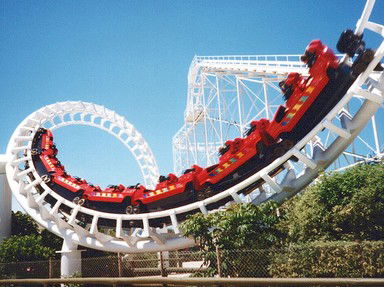Quiz Answer Key and Fun Facts
1. Pictured is one of North America's first looping coasters, Flip Flap Railway. With a loop that stood at about 25 feet (7.5 m), the ride opened in 1895 and closed by 1903, largely due to complaints from how painful it was. What theme park destination was home to the ride?
2. Inversions aren't just limited to vertical loop-de-loops! There are dozens of ways to flip a rider: zero-g rolls, stalls, sidewinders, sea serpents, dive loops, cobra rolls, bowties, and batwings. But the first coaster with a modern inversion, installed at Knott's Berry Farm, was named for its signature element. What was it (like many rides of the same model) called?
3. The vertical loops at your local theme park won't look like Flip Flap Railway. Rather than perfect circles, engineers call their shape "clothoid", but what word best describes them in layman's terms?
4. The designers of the first modern vertical loop, Schwarzkopf, have seen particular success making looping coasters that can be torn down and reassembled for traveling fairs. A great example is the coaster pictured here. Count those loops, and give me a guess to the name of this ride.
5. The graceful roller coaster maneuver pictured here makes you feel like a World War I flying ace - indeed, it's actually named for one. What pilot, called the "Eagle of Lille", lends his name to the coaster element?
6. Besides early experiments like Flip Flap Railway, no park has built a wooden roller coaster that inverts since the advent of modern safety standards.
7. One of the strangest roller coaster models to ever exist is the Screamin' Squirrel, produced by S&S Worldwide in the 2000s. As you can see, the draw of these rides was a sharp turn that wrapped you underneath the track. What woodwind instrument were these elements named for?
8. Moonsault Scramble was a 230-foot (70 m) Japanese roller coaster with a violent, unique inversion that bends over on itself. For over thirty years, no other ride dared to recreate it, until it was resurrected by Banshee at Kings Island (pictured here). What culinary name is given to this rare inversion?
9. If you compare the earliest corkscrews, the ride essentially rotates the rider by his feet. Alternatively, one more modern inversion style rotates riders around their center of mass. What heartening name is given to elements designed this way?
10. This gnarled mess of track is Kennywood's second 200+-foot coaster, which sought out to break the records for the most inversions in the U.S. and the highest inversion in the world. If I tell you that its colors are based on a local sports team's, can you tell me which American football defensive line was chosen as the name of this flip-happy ride?
Source: Author
etymonlego
This quiz was reviewed by FunTrivia editor
kyleisalive before going online.
Any errors found in FunTrivia content are routinely corrected through our feedback system.
